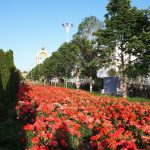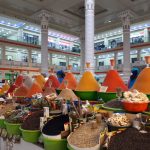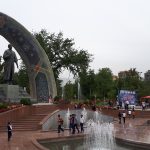The major city in Tajikistan, Dushanbe has a century-long history as an important cultural and political hub. Located where the Varzob and Kofarnihon rivers meet in south-western Tajikistan, Dushanbe with its leafy parks, fountains, and monuments, and surrounding snow-capped mountains is one of the most scenic capital cities in Central Asia.
Archaeological evidence (that can be seen in the National Museum of Tajikistan today) suggests that Dushanbe has been inhabited as far back as the 5th-century BC. However, it had humble beginnings as a small, rustic little village and many of the historic sites date back a century at most. The modern city as we know it today was built predominantly during the Soviet era on top of three early settlements, of which Dyushambe (as it was known in Russian) was the main one.
Dushanbe meaning ‘Monday’ in the Tajik language was named after the bustling bazaar that was held in the old village on Mondays (‘du’ means ‘the second day’ and ‘shambe’ means ‘after Saturday’). In the early 1920s, when the railway was built and the city’s textile industries swelled, Dushanbe became the capital of the Tajik Autonomous Soviet Socialist Republic. By the end of the 1920s, it was rechristened ‘Stalinabad’ (or the ‘City of Stalin’)” after Joseph Stalin as it was branded until the 1960s.
With the benefit of a working railway, the Soviets transformed the village into a prominent cotton and silk production hub along the Great Silk Road. Considered part of Tajikistan’s national identity and a symbol of independence, The Parchan monument outside the National Library now boasts the Tajiki emblem of ears of wheat and cotton bolls, along with a book, the sun, and snow-capped mountains.
Some of the city’s most important historical buildings were built during the time of the Soviets and several well-known architects, such as Peter Kuzmenko and Peter Vaulin, had a hand in crafting modern-day Dushanbe with its open, tree-dotted streets, historic buildings, and public squares.
A collection of historical buildings are believed to have important cultural significance in Dushanbe, including the Ayni Opera and Ballet Theatre and the former Palace of the President that served as the headquarters of the Tajikistan Communist Party. Today, the palace serves as the transitory office of the mayor (and son of the Tajik president), Rustam Emamali. Other historic buildings include the Chaykhona Rokhat teahouse, the Vahdat Palace, the Borbat Concert Hall, and the National Library that is shaped like an open book.
Having served the Soviets for over 30 years, the town reverted back to its original name, Dushanbe, in 1961 in an attempt to de-Stalinize Tajikistan. It has kept this name to this day. With the aim to erase its rather controversial Soviet history, many important Soviet-era buildings and markets have been (and are still to be) demolished and replaced with modern buildings in Dushanbe. The buildings that have already been demolished include the Russian Mayakovski Theatre and the Jami Cinema.
While the city boasts plenty of natural, historical and cultural allures, it is the Dushanbe weather that really draws tourists to explore this uncrowded section of the globe. It boasts a pleasant Mediterranean climate with a hot and dry summer and a mild winter that is perfect for exploring the region’s museums, parks, and lakes. Dushanbe Airport, an international airport that serves the city and a variety of top-rated Dushanbe hotels, makes Tajikistan tourism easily accessible for adventure travelers.
If you are wondering what to do in Dushanbe, there are several major highlights. Uncover the region’s fascinating history at the Tajikistan National Museum, the National Museum of Antiquities, the Ethnography Museum, and the Ismaili Centre.
Take a stroll along Rudaki Avenue, the main thoroughfare in Tajikistan that is lined with attractive plane trees. Previously known as Lenin Avenue during the Soviet era and once home to one of Tajikistan’s most famous Lenin statues, it was renamed Rudaki after the famous Tajik national poet in the early 1990s.
A statue of this same celebrated Tajik poet can be found in Rudaki Park Dushanbe – a popular picnic spot in the summer months – home to some of the most important landmarks and monuments of Tajikistan. It is also here that you can admire the 165-meter Dushanbe Flagpole (known locally as the Bayrak) one of the highest free-standing flagpoles in the world.
Head across to Friendship Square, the largest public square in Dushanbe, to see the famous golden statue of Ismoil Somoni. It commemorates the 10th-century founder of the Samanid Dynasty. Other things to do in Dushanbe include a visit to the hilltop Victory Park, home to a World War II tank monument and a traditional tea house, bargaining for souvenirs at the Shah Mansur Bazaar or the Mehrgon Market, and watching the nightly light and musical show of the dancing fountains outside the Ayni Opera and Ballet Theatre.
Take the kids to the Dushanbe Zoo or the Boghi Poytakht Park in Dushanbe with the big Ferris wheel, go for a stroll through the Dushanbe Botanical Gardens, or check out the party capital’s bustling restaurants, bars, and nightclubs. The best Dushanbe nightlife can be found at Port Said, Club People’s or the Chaykhona Rokhat with its live music.
As an important cultural center, Dushanbe also houses theatres and embroidery workshops, the Tajik State University, the Tajik Academy of Sciences, and the Bactria Centre where you can learn to speak Russian or Persian. The Wall of Great Tajik Writers is a highlight in Dushanbe. The wall of the Writers’ Union building is adorned with statues that honor 11 life-sized characters from Tajik literature.
Once you have discovered everything the capital has to offer, there are plenty of day trips from Dushanbe, Tajikistan. Take a drive to the Varzob Reservoir in the Varzob Gorge, explore the Iskanderkul Lakes, discover the Hissar Fortress, or have a picnic at Gusgarf Waterfall. The Sacred Spring Chiluchor Chashma is particularly enjoyable for a refreshing swim in the summer months which is located in the southern Tajikistan and possible to make it a day trip.
Dushanbe is a key stop on some of Paramount Journey’s other Tajikistan tours and itineraries. It can be combined with a trip to the Fann Mountains, a fantastic destination for hiking, mountain biking, and trekking.













